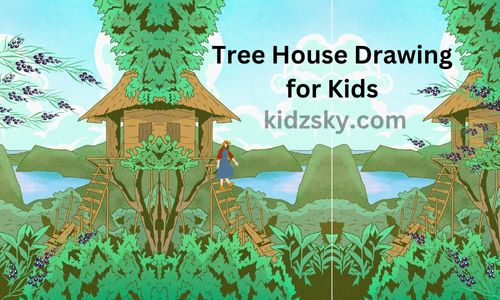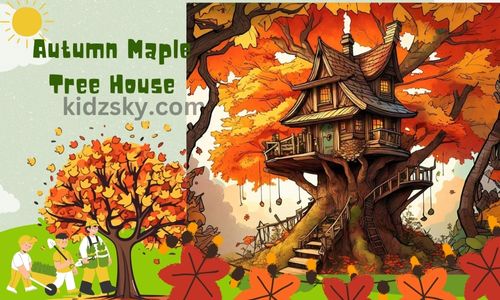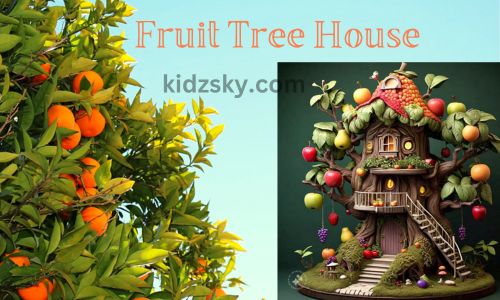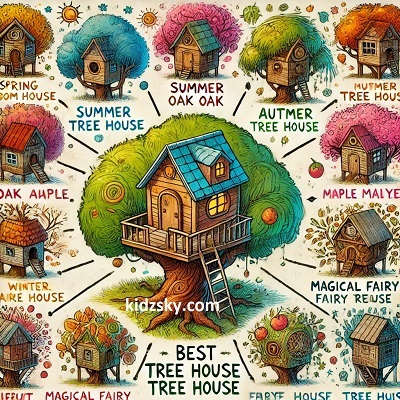Have you ever dreamed of having your own tree house? Well, let’s draw one! In this simple guide, Tree House Drawing for Kids, we’ll learn how to draw a cozy tree house.
Treehouse drawings let kids imagine and create, enhancing their skills and creativity; it’s a fun, nature-themed activity that excites young minds!
These activities keep them engaged, enhance fine motor skills, and encourage collaboration—making art a fun and beneficial part of their growth.

Introduction: Unleashing Creativity with Tree House Drawing for Kids
Treehouse drawings children’s imaginations, allowing them to design their dream hideaways while building artistic skills.
By exploring Tree House Drawing for Kids in different styles and seasonal themes, children can develop a greater appreciation for nature, creativity, and the art of storytelling.
This guide explores eight creative tree house designs, covering everything from the materials required to the drawing process, activity benefits, and tips for teachers and parents.

8 Creative Activity Ideas of Tree House Drawing for Kids

1. Spring Blossom Tree House
Materials Required:
- Drawing paper
- Colored pencils, markers, or crayons
- Reference images of spring blossoms
How to Design the Tree House:
- Draw a large tree trunk with branches extending outward.
- Add clusters of tiny flowers on the branches to represent spring blossoms.
- Sketch a simple tree house structure nestled among the blossoms.
- Color the tree with light greens and add pink or white for the blossoms.
Activity Benefits:
- Enhances understanding of seasonal changes.
- Teaches children about trees that bloom in spring.
- Encourages detail-oriented drawing with a focus on flowers and buds.

2. Summer Oak Tree House
Materials Required:
- Drawing paper
- Crayons, colored pencils
- Green and brown markers for shading
How to Design the Tree House:
- Start sketching a sturdy oak tree with a broad trunk and large leaves.
- Draw a wooden house on one of the lower branches, using lines to show wood texture.
- Add a rope ladder leading to the ground.
- Use vibrant green for the leaves and warm brown for the house.
Activity Benefits:
- Introduces children to the characteristics of oak trees.
- Builds hand-eye coordination through detailed shading.
- Enhances outdoor scene creativity and drawing skills.
Kids Favorite:- The Joy and Benefits of Playing in Mud for Kids: 9 Best e.g.

3. Autumn Maple Tree House
Materials Required:
- Colored pencils in fall colors (orange, yellow, red)
- Drawing paper
- Black marker for outlines
How to Design the Tree House:
- Draw the tree’s trunk and branches with a focus on adding texture.
- Sketch a small tree house with a window, blending in with the autumn foliage.
- Surround the house with red, orange, and yellow leaves.
- Outline with a black marker for a finished look.
Activity Benefits:
- Teaches children about seasonal colors.
- It helps in learning to layer colors to create depth.
- It provides an opportunity to express creativity with autumn scenery.

4. Winter Pine Tree House
Materials Required:
- White and blue colored pencils for snow effects
- Drawing paper
- Crayons or markers
How to Design the Tree House:
- Begin with a tall, narrow pine tree with layered branches.
- Draw a small, cozy tree house nestled in the branches, adding snow around it.
- Use blue and white pencils to add snowy details and create a frosty atmosphere.
- Add simple touches like icicles and frost on the tree house.
Activity Benefits:
- Introduces kids to winter and pine trees.
- Teaches about cold climates and snow effects.
- Encourages storytelling and creative imagination in a winter setting.
Guide For Kids:- The Importance of Setting Limits and Boundaries for Kids
5. Tropical Palm Tree House
Materials Required:
- Drawing paper
- Green and brown crayons or markers
- Yellow and blue colors for tropical background
How to Design the Tree House:
- Draw a tall palm tree with broad leaves, adding texture to the bark.
- Sketch a small tree house attached near the trunk with a rope bridge to another palm.
- Add a beach or tropical background with blue skies and yellow sun.
- Use bright colors to represent a tropical setting.
Activity Benefits:
- Encourages kids to think about different habitats and environments.
- Develops creative expression with bright colors and unique backgrounds.
- Builds understanding of tropical ecosystems.

6. Fruit Tree House
Materials Required:
- Drawing paper
- Colored pencils or crayons in red, green, yellow, and pink
- Black marker for details
How to Design the Tree House:
- Draw a tree with several branches and add round shapes for fruits (e.g., apples, oranges).
- Design a tiny house perched on the branches, surrounded by fruits.
- Add leaves around the fruits and give color to each piece.
- Use a black marker to outline and highlight the fruits and tree house.
Activity Benefits:
- Encourages children to learn about fruit-bearing trees.
- Enhances fine motor skills through drawing details.
- Fosters creativity and love for nature.
Best Habits:- Teaching Kids the Value of Gratitude: 7 Best Lifelong Gift

7. Magical Fairy Tree House
Materials Required:
- Drawing paper
- Glitter markers, colored pencils
- Star stickers or metallic markers for a magical effect
How to Design the Tree House:
- Draw a whimsical tree with twisted branches, adding small windows and a doorway.
- Include magical elements like fairy lights or floating steps.
- Add fairy characters around the tree for a magical touch.
- Use glitter or metallic markers to highlight magical features.
Activity Benefits:
- Encourages imaginative storytelling and fantasy.
- Builds a creative approach with colors and glitter.
- It helps in understanding fantasy themes and magical creatures.

8. Jungle Banyan Tree House
Materials Required:
- Drawing paper
- Green and brown crayons or markers
- Black pen for texture details
How to Design the Tree House:
- Start by drawing a banyan tree with aerial roots extending to the ground.
- Sketch a small tree house in the thick branches, making it look hidden among roots.
- Add jungle animals or vines for added effect.
- Use greens and browns to shade the tree and house.
Activity Benefits:
- Introduces children to jungle ecosystems and banyan trees.
- Enhances observation skills with detail-oriented drawing.
- Encourages curiosity about different tree structures and habitats.
Guidelines for School Teachers
- Prepare Materials Ahead of Time: Collect all materials required, such as crayons, colored pencils, paper, and any additional items like glitter or stickers, before the class begins.
- Show Examples: Display tree house drawings in the classroom to give children inspiration and a visual goal.
- Provide Step-by-Step Assistance: Guide students through the steps to ensure everyone understands the process of each tree house drawing.
- Encourage Creativity: While teaching each activity, allow students to make creative changes to their designs to make them unique.
Guidelines for Parents
- Create a Comfortable Space for Art: Set up a designated area for your child to draw without distractions.
- Support with Encouragement: Encourage children to express themselves freely and reassure them that every drawing is a work of art.
- Join the Fun: Participate by drawing alongside your child. This can be a fun bonding experience that inspires them.
- Showcase Their Work: Dispchild’sr child’s tree house drawings to show appreciation for their effort and creativity.
How to Play the Activity
- Choose a Theme: Let each child choose their favorite tree house, whether it’s its typical setting, fairy theme, or seasonal tree.
- Gather Supplies: Ensure all required materials are at hand.
- Guide the Drawing Process: Help children follow the design steps, focusing on details specific to their chosen theme.
- Create a Story: Once the drawing is complete, encourage children to create a story about their tree house—who lives there, what adventures might happen there, etc.
- Share and Discuss: Let each child present their tree house drawing to the group and discuss what inspired their creation.
For Parents:- The Benefits of Positive Parenting: Brighter Future of Child

Conclusion: Inspiring Creativity with Tree House Drawing for Kids
Treehouse drawing for kids is an enjoyable and highly beneficial activity that fosters creativity, fine motor skills, and an appreciation for nature.
Children can connect with seasonal themes, diverse ecosystems, and fantasy worlds by exploring these eight unique designs. Teachers and parents are crucial in guiding and encouraging young artists through each step.
Ultimately, these activities create an imaginative world, offering endless possibilities and joyful experiences through art.






Pingback: 10 Creative Activities for LKG Class: Learning Through Fun!
Pingback: 7 Best Benefits of Storytelling in Early Childhood Education
Pingback: Impact of Family Routines on Children's Growth: 8 Benefits
Pingback: Handmade Gift Ideas for Kids: 8 Best Presents They Can Make - kidzsky.com
Pingback: 15 Fun Photography Projects for Kids: Spark Their Creativity